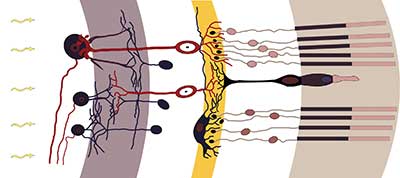Paul Kwiat
 Pursuing Human Vision at the Quantum Level
Pursuing Human Vision at the Quantum Level
Despite the fact that more than 70 years have passed since the first low-light vision experiments, it remains an open question whether humans can see single particles of light--“photons.” Professor Kwiat’s lab has developed unique hardware and methodology to definitively answer this question, by reliably preparing pulses of light containing exactly one, two, or any small number of photons. The photon is directed at random to one of two sets of rods in the observer’s retina; by forcing the observer to choose where they believe they saw the photon (including cases where it was lost before hitting the retina), single-photon sensitivity can be determined more accurately than random guessing would allow simply by looking for correct answers.
In addition to coordinating a new multidisciplinary NSF-INSPIRE grant to investigate this topic, the CAS appointment will enable Professor Kwiat to develop the requisite technical capabilities to incorporate “adaptive optics” into the experiment. By using deformable mirrors, eye-tracking hardware, and holographic techniques, it should be possible to direct photons onto individual rods. The overall detection efficiency should increase, as photons can no longer hit the dead space between rods. Moreover, one can test the phenomenon of visual adaption (reduced sensitivity to a repeated stimulus) at the single-photon level, and if present, intentionally use different rods for subsequent trials. Finally, one can study the visual response to different spatial patterns of light, thereby directly measuring the rod cells’ neuronal linkages. This latter would eventually enable the capability to “prime” the neuronal circuit, so that the visual system can have an improved efficiency at detecting the next photon directed to the rod of choice. Achieving the required precision will be nontrivial, but the payoff would be an extremely powerful measurement system, enabling entirely new types of experiments on the human visual system at the single-quantum level.
